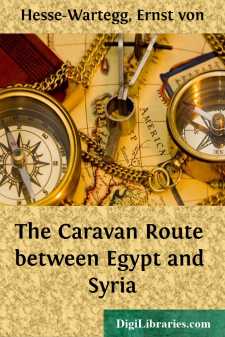Categories
- Antiques & Collectibles 13
- Architecture 36
- Art 48
- Bibles 22
- Biography & Autobiography 813
- Body, Mind & Spirit 142
- Business & Economics 28
- Children's Books 17
- Children's Fiction 14
- Computers 4
- Cooking 94
- Crafts & Hobbies 4
- Drama 346
- Education 46
- Family & Relationships 57
- Fiction 11829
- Games 19
- Gardening 17
- Health & Fitness 34
- History 1377
- House & Home 1
- Humor 147
- Juvenile Fiction 1873
- Juvenile Nonfiction 202
- Language Arts & Disciplines 88
- Law 16
- Literary Collections 686
- Literary Criticism 179
- Mathematics 13
- Medical 41
- Music 40
- Nature 179
- Non-Classifiable 1768
- Performing Arts 7
- Periodicals 1453
- Philosophy 64
- Photography 2
- Poetry 896
- Political Science 203
- Psychology 42
- Reference 154
- Religion 513
- Science 126
- Self-Help 84
- Social Science 81
- Sports & Recreation 34
- Study Aids 3
- Technology & Engineering 59
- Transportation 23
- Travel 463
- True Crime 29
The Caravan Route between Egypt and Syria
Categories:
Description:
Excerpt
EL KANTARA.
One of the Suez Canal Company's tugs soon took us down the canal from Ismailia to El Kantara (the bridge), where we were to meet our caravan. Just as we were landing we observed the first few horses of the latter crossing by the ferry which plies between the two sides of the canal. The boat had to go over three times to get all our animals and luggage, and we found it no easy work on the other side to strap up all our things ready for the journey. Matters seldom go altogether smoothly on the first day of a caravan expedition. At length a start was made, the mules laden with our tents and luggage going on in front, and ourselves bringing up the rear. The little hotel of El Kantara, with the few patches of vegetation surrounding it, was the last sight we had of civilised life. Following the telegraph posts, which mark the route from Egypt to Syria, we then entered the rolling desert, and soon began to enjoy that feeling of freedom which a boundless plain always inspires. Only life on the sea, with all its wonderful charms, is to be compared to a journey through the desert. In the midst of its vast and solitary expanse the traveller feels himself overwhelmed, and his imagination conjures up strange forms on the far horizon. The desert is to the Arab what the sea is to the sailor; for both, their proper element has a permanent and irresistible attraction. Old Abou Nabout, the leader of our caravan, rode on quietly in front, his eyes gazing steadfastly across the sandy plain, and dreams of his youth doubtless floated through his mind as his horse threw up clouds of sand with his hoofs.
Our first ride soon came to a pause, for instead of encamping at two hours' distance from El Kantara, as I had ordered, the moukri (mule-driver) unpacked our tents in a small sandy valley which we reached in half an hour only. Knowing from experience how necessary it is to insist upon the execution of orders once issued, especially at the commencement of a caravan journey, I made the moukri pack up again, at which he was evidently not best pleased. We then continued our course until we came to a shallow depression of the sandy ground, where I directed our tents to be pitched. We travelled in a comparatively comfortable manner, being furnished with two tents for sleeping, and a third in which we took our meals. Besides these, we had a smaller tent for a kitchen.
Everything was unpacked—our stores, the forage for our animals, and the water casks. These had to pass a careful inspection by our old leader, who repaired those which were leaky. The thirsty mules and donkeys were taken back to El Kantara to drink, and the camels were driven to graze in the neighbourhood, where were a few tamarisks, Salsola echinus, Portulaca, and other plants of the desert.
Our tents were soon in order, and under their shelter we at last enjoyed our rest. Before sunset we saw our animals return from El Kantara. Horses and mules were then re-saddled and fastened together in a straight line to a long rope....


